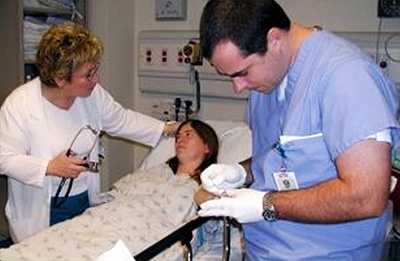AMD Projects: Next-Generation Malaria Methods
Replacing outdated malaria drug resistance screening methods with next-generation molecular tools and techniques

Emergency department staff evaluates a patient with fever who had traveled recently to a malaria-endemic country. Malaria should be considered a potential medical emergency and should be treated accordingly. Delay in diagnosis and treatment is a leading cause of death in malaria patients in the United States.
The Plasmodium parasite that causes malaria continuously evolves ways to counter anti-malarial drugs. Malaria control efforts based on the use of chloroquine faltered in the 1960s when drug-resistant Plasmodium falciparum parasites evolved. Other malaria drug regimens—such as sulfadoxine-pyrimethamine and mefloquine—also failed in many regions due to emergence of resistance. Recently, resistance to current first-line treatments—known as artemisinin-based combination therapies—has emerged in Southeast Asia. A serious concern is the potential spread of these resistant parasites to other regions.
In addition to hampering malaria control efforts in countries where malaria is common, resistance complicates treatment of patients who have returned to the US after being infected overseas.
Molecular markers associated with resistance to anti-malarial drugs can help detect resistant parasites. CDC uses conventional molecular tools for characterizing molecular markers, but these are cumbersome, slow, and expensive. Highly sensitive, efficient, and integrated surveillance methods will improve identification of established and emerging drug-resistant strains and allow CDC to respond rapidly to changes needed in case management and control.
CDC is developing next generation sequencing methods to detect resistant parasites rapidly. These methods will allow CDC to detect even a small number of resistant parasites present. Early identification of low levels of resistant parasites will make it easier and faster to choose the right drugs for treatment than current practices allow.
Once the new advanced molecular detection methods are fully developed and integrated, they will replace the slower and less sensitive methods now in use.
2017 Project Update
During the first three years of this project, investigators made strides in developing AMD methods to characterize and analyze drug resistance genes in Plasmodium falciparum, the deadliest of the four malaria-causing parasite species. Using next generation sequencing (NGS), researchers developed protocols that detect mutations for drug resistance faster, identify minor mutations more accurately than previous methods, and provide a unified drug resistance profile for each patient sample. These new protocols will vastly improve drug-resistant malaria surveillance.
In addition to NGS protocols, researchers developed data analysis tools, including an open-source and standardized computer software system, called Malaria Resistance Surveillance (MaRS), for automated data analysis to pinpoint genetic markers of drug resistance in malaria-causing parasites. CDC researchers are working with laboratory professionals at the New York Wadsworth Center to validate and standardize these tools. Once fully developed and validated, laboratories can routinely use these AMD methods for molecular surveillance of drug resistance in imported malaria cases in the U.S., as well as for international projects CDC supports. Collectively, this work will result in a more robust and efficient molecular surveillance method for tracking drug resistant malaria parasites.
- Page last reviewed: March 22, 2016
- Page last updated: March 22, 2016
- Content source:


 ShareCompartir
ShareCompartir